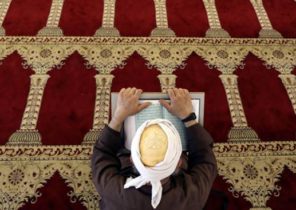In the winter of this year before the pandemic coronavirus I was lucky enough to travel around lake Baikal and get acquainted with its unique nature and rich history. They want to share their enthusiasm with readers.
The end of February. Irkutsk. Frosty morning. Frosty is not the word. Minus 27 degrees Celsius. Wind increases the sensation of cold. But I’m not giving up: on top of the thermal underwear, two sweaters, insulated pants with fleece, warm jacket, Alaska, two woollen hats and high boots with fur. So, in a way! Oddly enough, I can easily sustain such a low temperature.
We arrived to Irkutsk with the airline S7 with a stopover in Vladivostok. Stayed in a very decent hotel “Angara”. When traveling to the hotel in the evening from the airport, I was struck by the fact that the lights of the city from the cold was like a hazy, and the air sparkled. Incredibly beautiful.
Here it is, the harsh ice-bound lake Baikal
Our guide Tom, who is very well spoken in German (I specifically asked for a German-speaking tour guide, since he studied the language at University) takes us to the village of Bolshoe Goloustnoe. It was a small neat settlement with the Orthodox Church in the center. To the shore of lake Baikal is literally on the doorstep.
Ice covering a huge lake just incredibly transparent. It is bluish-white. Just scared to go as if walking on the glass above the abyss. The smallest visible rocks on the bottom. This is quite different from the freezing of lakes in Japan, Hokkaido. There is such transparency is not in sight. Some people skate and just squeal with delight.
Apparently, under the influence of wind the ice of lake Baikal is incredibly slippery. Artem all the time and tells us about the observance of caution, in order not to fall. “To shoot video on the go is very dangerous!”
If you need ice, go in located in the centre of the village restaurant “Mihalich”. Artem says that the tourist seasons here — summer and the middle of winter. Among tourists, a lot of Russian.
“For sugreva” ordered some vodka and snacks. Artem explains that vodka is not savor the wine. Swallow it at one stroke small portions so that it immediately fell into the stomach. Then will come the sensation of heat. I put 50 grams. Drink it at half. Surprisingly, numb hands and feet from warm.
Clear soup from pride of lake Baikal — omul. Matchless delicacy!
Further ordered soup from a local landmark — Cisco. Meat of this fish is tender and fatty. Served an impressive plate. On the surface of the soup floating a beautiful Golden droplets of fat.
Then go to the local gedza — here they are usually called “Pozi”. They are quite large, unusual round form with a beautiful ornament. They say they trace their history from nomadic tribes who lived on the shores of lake Baikal. There they need to be carefully, preferably with your hands, opening up and not much nadkusyvat to leaking meat juice.
Place of Baikal where the Angara river flows out
The next day we go to the town of Listvyanka, which also stands on the shore of lake Baikal (70 km from Irkutsk). This is the start of the famous Siberian river Angara. Into the lake flows into many rivers, but derives therefrom the one and only- beauty Angara. Legend has it that the Hangar was the favorite daughter of her father — lake Baikal. She fell in love with a beautiful young man — Yenisey. Despite the protests of his father, ran to him and they’re together now flowing to the Arctic ocean. And the place the flight of the Angara from lake Baikal remained the devil-the rock that simply father left after the fugitive, to stop her.
In Listvyanka is the famous fish market where they sell fish of different varieties, but above all, Cisco. Here he smoked, and salted, and dried. The place is very colorful. Another local delicacy — the pine nuts. Surprisingly delicious thing.
The cemetery of Japanese prisoners of war
In Listvyanka there is a cemetery of Japanese prisoners of war who died in Siberia after the Second world war. The names of the buried here of Japanese soldiers knocked out “in katakana” at the neat granite columns that stand in rows throughout the cemetery. After the war in captivity in the former Soviet Union was many Japanese. Approximately one in ten of them returned to Japan and buried in special cemeteries. Only in the Irkutsk region such graves more than 80. Baikal is the biggest of them.
Having experienced a Siberian winter, I imagined the hardships that befell my countrymen, caught in Soviet captivity. It’s cold and hunger, and hard work.
They are buried away from their homeland. Here it occurred to me that nowhere in the world can not forget the horrors of war and of the victims.
In Listvyanka I lived in the hotel “Mayak”. From the balcony of my room had beautiful views of the boundless latitude of lake Baikal. In the distance could be seen shrouded in haze the mountains of Buryatia.
Today I went for a walk on the ice of the lake and didn’t even feel the cold. In fact, the temperature “up” to minus 12 degrees Celsius. Our guide said, “Oh, Yes, today, quite warm!”. I think so. Are already used to. Indeed, until recently the subzero temperatures in Tokyo seemed to be a disaster!
Traveling by snowmobile hovercraft
Departure from Listvyanka to Tankhoi village in Buryatia, on the opposite shore of Baikal. Go on the snowmobiles, hovercraft, crossing the surface of the lake directly on the ice. Sled race on marked and utrennei track. The snowmobiles offer. As in a passenger car. The first time I travel that way. A little shaky, but overall the sled is going surprisingly smoothly. They raise around a cloud of snow dust, so it seems that rushing in the storm. And this in the bright sun! Amazing!
A 45-minute drive, and we are in Tahoe. Hence the car going in the capital of Buryatia Ulan-Ude. It is approximately 4 hours, although going fast enough. How wide is this Russia!
Beautiful affluent village of Tarbagatai, in which the lives of amazing people of Semey were Orthodox believers
The next day we go to the village of Tarbagatay, located 60 kilometers South of Ulan-Ude. It is quite large, with a population of about 4,300 people.
Here live the descendants of those who, after the Church schism that occurred in the Russian Orthodoxy in the seventeenth century, fled from persecution on the territory of modern Poland. One hundred years later, this territory became part of the Russian Empire. In the first half of the eighteenth century the old believers returned to Russia. Resettlement policy framework they came to Siberia, where they received large land holdings. And here already throughout more than 250 years, they live in these places, and keep intact cultural and historical heritage of the old believers, as well as the life and customs of its speakers.
Living in Tarbagatai descendants of old believers known as Semey, and in full compliance with this title above all put family ties and mutual support. They live in the surrounding untouched nature, mainly in subsistence farming.
In Tarbagatay we met local dishes, and ancient ritual songs and dances
In Tarbagatay we were invited into one of the houses, and at first properly treated and then showed traditional dances and delighted by the tunes.
Meat, vegetables, cereals and dairy products Semey produce in their backyards. The natural taste of the food pleases the soul and body. Kindness really touched us. In the households of tarbagataicum in the summer-autumn period produces a lot of different pickles. They go well with meat and fish.
Semey has performed for us singing different tunes — a wedding, a birthday, chants and so on. Although language we didn’t understand, but these songs touched the soul. Especially wedding. Joyful, filled with anticipation of happiness. And sad at the same time, when parents are sad about the departure of the bride from her home. Now life even the believers are changed. Some young people go to study in Ulan-Ude. But many return to their homes.
In the centre of Tarbagatay is a small Orthodox Church where services are held according to the old Canon. And opposite the Church is a local Museum depicting the history and life of the local people. There are many interesting objects, from paintings, icons and household items to the Bridal and festive garments and widely used in the shiny samovar. By the way, the culture of Transbaikalian old believers — semeiskie — included on the UNESCO list of masterpieces of the world intangible heritage of humanity.
Living in the harsh natural conditions tarbagataica love bright colors. On the houses they have bright trim, the walls are often painted with colors and patterns.
This is a cheerful and hard-working people, piously reveres its national identity. They are simple and heartfelt. After meeting with them I wanted to come here again.
Kiyoko Aihara — known in Japan writer traveling the world and writing about cultural, historical and ethnographic heritage of different countries. In Japan, became popular her books about the history and culture of Germany, France, Hungary, Scandinavia and the Baltic States. He regularly appears in the press. Subject to foreign activities, “the Japan Foundation” by the Japanese embassies. In Europe the wide popularity won her book “Geisha — a living tradition”, translated into many European languages.





